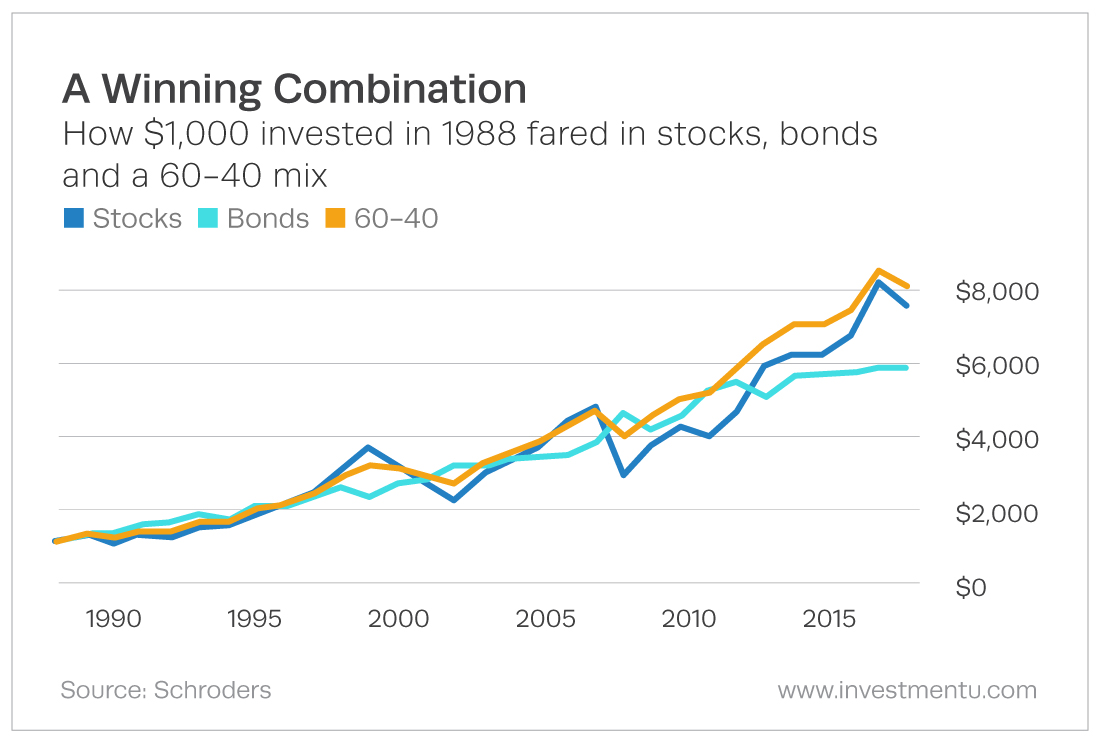60-40 Rule of Investing: Is It Still Relevant?

“What is the new 60-40 Rule?” This is a great question we recently received from Investment U reader Janice F. We liked it so much that I decided to devote an entire column to it.
Janice is referring, of course, to the classic rule of investing that says you should have 60% of your portfolio in stocks or similarly high-risk assets and the remaining 40% in very safe assets like government bonds.
The rule, which has served as the benchmark for many asset allocation strategies for decades, was popularized by Jack Bogle, legendary founder of the Vanguard Group, who invented index investing. And it’s no wonder it’s lasted as long as it has, as the 60-40 stocks-to-bonds ratio has been (largely) a winning combination.
The chart below from Schroders, an international investment management firm, shows how $1,000 invested in 1988 performed in just stocks (as measured by the MSCI World Index), just 10-year Treasurys and a 60-40 mix.

Is the 60-40 Rule Dead?
As you can see, the 60-40 allocation has indeed outperformed portfolios with just stocks or just bonds. Yet in recent years, investment analysts and economists have been proclaiming the death of the 60-40 rule. Many say that asset allocation strategies need to be more sophisticated.
Income Expert Marc Lichtenfeld says that this long-adhered-to rule just isn’t that useful. “The 60-40 rule is too one-size-fits-all. Each investor has different goals, needs and tolerance for risk. If an investor expects to live a long time and can tolerate risk, 60-40 may be too conservative. Conversely, someone who cannot handle any downside may find that ratio too aggressive.”
Some investment analysts say that a mix of high-quality, high-dividend-paying stocks can be a surrogate for bonds in a new kind of 60-40 allocation strategy. Marc knows all about that, and he’s created the Ultimate Dividend Package to show you just how to invest in those stocks. Check it out here.
I think Marc’s take on the 60-40 strategy is exactly right. But today, there’s an even better reason to dump the rule: Bond yields have been falling for years. Take a look at this chart of 30-year Treasury yields since 1980.

And the 10-year Treasury? Its yield has fallen from 9.5% in 1989 to around 1.6% today. But that’s the nominal yield. The real yield, or what your return is after accounting for inflation, is negative, or around negative 0.65%. So you’re losing money (or more accurately, purchasing power) when you put money into Treasury securities.
A Very Long Trend
And this trend looks likely to continue. A 2020 research paper published by the Bank of England shows that yields on government debt have been declining since the late Middle Ages. And it doesn’t appear that this trend will reverse anytime soon, no matter what the Federal Reserve or any other central bank or government does in the near future.
So allocating 40% of your portfolio to assets that have a negative return that just keeps getting worse is, well… a bit outdated. And I think Janice was hinting at exactly that with her query about the “new 60-40.”
The Gone Fishin’ Asset Allocation
So to answer this million-dollar question, I turned to Chief Investment Expert Alexander Green. “Well, I’ve written a whole book on my exception to the 60-40 rule,” he responded. “It’s The Oxford Club’s asset allocation model as exemplified by the Gone Fishin’ Portfolio.”
You can read all about it in Alex’s book of the same name (which was recently revised and expanded, with a new foreword by Bill O’Reilly). But in short, here is Alex’s Gone Fishin’ asset allocation.

You can see that he has 60% allocated to a mix of U.S. and international stocks. About 10% goes into real estate and gold.
And then there is 30% in bonds – but not the same bonds discussed above. Alex advises putting this portion into short-term corporate bonds that have higher yields, as well as so-called junk bonds, which pay even higher rates of interest (though still with low default rates). Finally, 5% of this portfolio goes to government bonds, but only those that are adjusted for – and protected from – inflation.
This allocation model “is designed to be both aggressive enough to boost your long-term returns and uncorrelated enough to smooth out the inevitable bumps along the way,” according to Alex’s book.
There are many new allocation models, of course. But if you’re after both the better returns that come from stocks and the smoothing and stability that bonds can offer, Alex’s model is about the best place to start that I can think of.
Finally, I want to thank Janice for a great 60-40 rule of investing question. And to other readers, please send us your thoughts and questions. You can email them over to me right here. I look forward to hearing from you! Don’t forget to subscribe to our free Investment U E-letter today!






